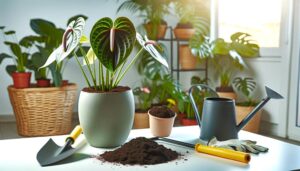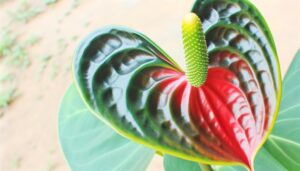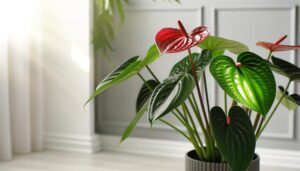Complete Guide to Caring for Anthurium King and Queen
To care for Anthurium King and Queen, provide bright, indirect sunlight and maintain temperatures between 65-80°F. Maintain a humidity level of 70-80% and use well-draining, organic-rich substrates like orchid bark and peat moss.
Water when the top inch of soil is dry, and avoid root rot by ensuring proper drainage. Feed with a diluted, balanced, water-soluble fertilizer every two weeks.
Regularly check for pests like spider mites and root rot. Propagate via stem cuttings and division.
With these detailed tips, you’ll master their vibrant growth and health. Discover advanced methods and nuanced care strategies ahead.

Key Takeaways
- Ensure bright, indirect sunlight and avoid direct sun to prevent leaf damage.
- Maintain temperatures between 65-80°F and humidity levels at 70-80%.
- Water when the top inch of soil is dry, using tepid, filtered water.
- Use a well-draining, organic-rich potting mix with components like orchid bark, perlite, and peat moss.
- Apply diluted, balanced, water-soluble fertilizer every two weeks to promote growth and health.
Understanding Anthurium King and Queen

Understanding Anthurium King and Queen demands a thorough investigation into their botanical traits, distinguishing attributes, and specific growth needs.
You’ll notice that Anthurium warocqueanum (Queen) and Anthurium veitchii (King) are celebrated for their impressive foliage. The Queen’s elongated, dark green leaves exhibit prominent white veins, creating a majestic look.
In contrast, the King showcases corrugated, strap-like leaves, often reaching significant lengths. Both species flourish in well-draining, organic-rich substrates, resembling their natural epiphytic surroundings.
Maintaining humidity levels around 70-80% is vital, as their native habitats are tropical rainforests. Regularly misting or using a humidifier will support their growth.
Additionally, ensuring temperatures stay between 65-80°F (18-27°C) to encourage optimal well-being. Understanding these elements will empower you to nurture these splendid plants effectively.
Ideal Light Conditions
Promoting the best light conditions for Anthurium King and Queen involves providing bright, indirect sunlight to mimic their native rainforest understory environments.
You shouldn’t expose these plants to direct sunlight, which can cause photoinhibition and leaf scorching. Instead, place them near east or north-facing windows where they receive diffused light.
If natural light is insufficient, you can use fluorescent or LED grow lights with a spectrum range of 400-700 nm to replicate natural sunlight. Rotate the plant periodically to guarantee even light exposure and prevent phototropic growth.
Watering Requirements
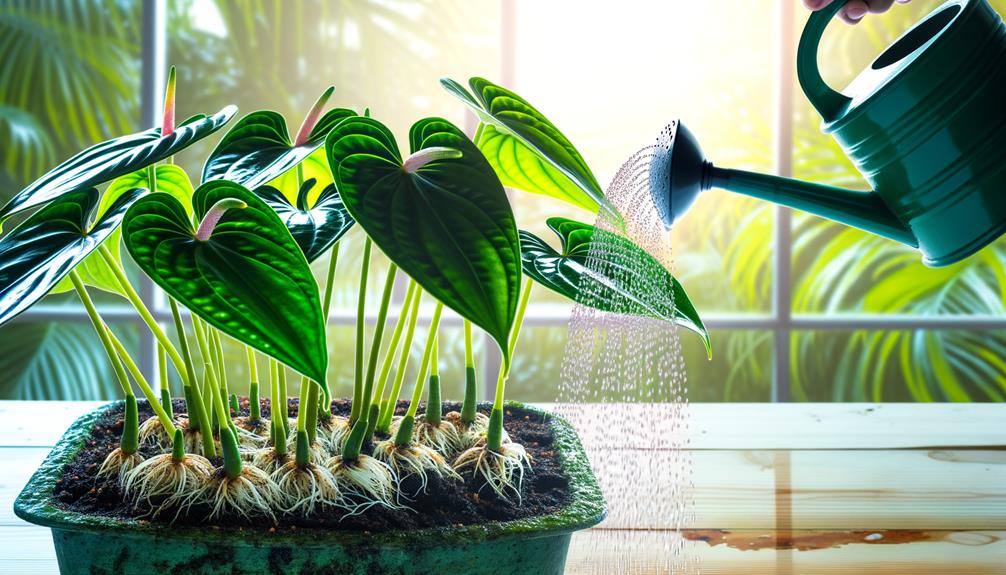
Proper hydration is vital for the health and growth of Anthurium King and Queen. This requires a balanced watering approach to prevent both drought stress and waterlogging. Water your Anthurium when the top inch of soil feels dry to the touch.
Utilize tepid, filtered water to avoid introducing chlorine and fluoride, which can harm the plant. Ensure thorough watering until water drains from the pot’s bottom, promoting deep root hydration.
Be mindful of humidity levels; these tropical plants thrive in 60-80% humidity. Employ a humidity tray or mist regularly to maintain ideal moisture levels.
Avoid allowing the plant to sit in standing water, as this can cause root rot. Proper hydration guarantees robust, vibrant foliage and healthy growth.
Soil and Potting Mix
When selecting soil for your Anthurium King and Queen, focus on a composition rich in organic matter with excellent drainage properties, such as a mix of pine bark, perlite, and peat moss.
Prioritize proper potting techniques by not compacting the soil too tightly, allowing roots to breathe and grow.
Emphasize drainage and aeration to prevent root rot and promote prime growth conditions.
Ideal Soil Composition
Have you considered the importance of a well-draining potting mix rich in organic matter for your Anthurium King and Queen? These tropical plants thrive in a substrate that mimics their natural epiphytic environment.
You’ll need a mix containing orchid bark, perlite, and peat moss. Orchid bark offers aeration and prevents compaction, perlite guarantees drainage, and peat moss retains moisture while providing acidity. Aim for a slightly acidic pH of 5.5 to 6.5.
Adding charcoal can help absorb impurities, enhancing root health. Avoid heavy, water-retentive soils that can lead to root rot. Maintaining the right balance between aeration, moisture retention, and nutrient availability is key to your Anthurium’s vigorous growth and vibrant blooms.
Proper Potting Techniques
Choosing the right pot and using precise potting techniques ensure that your Anthurium King and Queen flourish completely in the ideal soil mixture you’ve prepared. Select a container with sufficient space for root expansion.
Utilize a blend that includes orchid bark, peat, and perlite. The orchid bark provides structural support, peat retains moisture, and perlite improves soil aeration.
Here’s a simple table to assist you:
| Component | Function | Ratio |
|---|---|---|
| Orchid Bark | Structural support | 40% |
| Peat | Moisture retention | 30% |
| Perlite | Soil aeration | 30% |
Thoroughly combine these components. This potting mix will offer the necessary balance of moisture, aeration, and support, promoting healthy growth for your Anthurium King and Queen.
Drainage and Aeration
Effective drainage and aeration are essential for preventing root rot and ensuring ideal oxygen flow to the roots of your Anthurium King and Queen. You must use a potting mix that balances moisture retention and aeration.
Incorporate the following components:
- Perlite or pumice: Enhances soil aeration and prevents compaction.
- Orchid bark: Promotes drainage while retaining necessary moisture.
- Sphagnum moss: Maintains moisture levels without waterlogging the roots.
Choose a well-draining pot to complement this mix, ensuring excess water can escape. Avoid heavy, compact soils that suffocate roots and cause water retention.
Temperature and Humidity

To optimize the growth of your Anthurium King and Queen, maintain a temperature range of 65-80°F, as they thrive in warm conditions.
Guarantee humidity levels remain consistently high, ideally between 70-80%, by using a humidifier or misting regularly.
Avoid temperature fluctuations, which can stress the plants and impede their development.
Ideal Temperature Range
Maintaining an ideal temperature range of 65-80°F (18-27°C) and high humidity levels of 70-80% is essential for the healthy growth of Anthurium King and Queen. These conditions mimic their native tropical environment, promoting peak physiological functions.
Temperature fluctuations can stress the plants, leading to stunted growth and leaf chlorosis. To optimize your Anthuriums thrive, consider:
- Consistent Temperature: Avoid placing plants near drafty windows or air conditioning vents.
- Humidity Monitors: Utilize hygrometers to maintain accurate indoor humidity levels.
- Microclimate Creation: Use terrariums or humidity trays to create a controlled environment.
Maintaining High Humidity
You must make sure that your Anthurium King and Queen receive consistent high moisture levels to support their physiological needs and prevent desiccation. Aim for a relative moisture of 70-80%.
Utilize a hygrometer to monitor ambient wetness accurately. To achieve this, you can employ a humidifier, set up a moisture tray with water and pebbles, or frequently mist the foliage using distilled water to avoid mineral buildup. Grouping plants together also creates a microenvironment with elevated moisture.
Ensure ventilation to prevent fungal growth and maintain air circulation. Avoid placing your Anthuriums near air conditioning or heating vents, as these can drastically lower moisture. By maintaining best moisture, you’ll foster robust growth and vibrant foliage.
Avoiding Temperature Fluctuations
Achieving consistent high moisture levels is only part of the equation, as Anthurium King and Queen also require stable temperatures to thrive.
You should maintain a constant temperature between 65-75°F (18-24°C). Avoid placing your plants near drafts or heating vents, as sudden temperature fluctuations can stress them.
Thermal Regulation: Use a digital thermostat to monitor room temperature.
Microclimate Creation: Place the plants in a terrarium or under a humidity dome.
Heat Mitigation: Employ shade cloths or blinds to diffuse excessive sunlight.
Understanding the thermodynamic principles at play guarantees your Anthurium King and Queen maintain metabolic homeostasis.
This minimizes the risk of physiological stressors that could impede growth and essentiality. By controlling the environment, you empower your plants to flourish.
Fertilization Tips
To guarantee robust growth and vibrant blooms in your Anthurium King and Queen, apply a balanced, water-soluble fertilizer with a ratio of 20-20-20 every two weeks during the growing season.
This formulation provides equal parts nitrogen (N), phosphorus (P), and potassium (K), essential macronutrients for overall plant health.
Nitrogen promotes vigorous foliar growth, phosphorus supports root development and flowering, and potassium enhances overall plant resilience.
Dilute the fertilizer to half the recommended strength to avoid nutrient burn, ensuring a steady, manageable nutrient uptake.
Avoid fertilizing during dormancy, as it can stress the plant. Consistent feeding, coupled with proper watering and light, will lead to anthuriums that thrive and flourish, giving you the freedom to enjoy their natural beauty.
Common Pests and Diseases
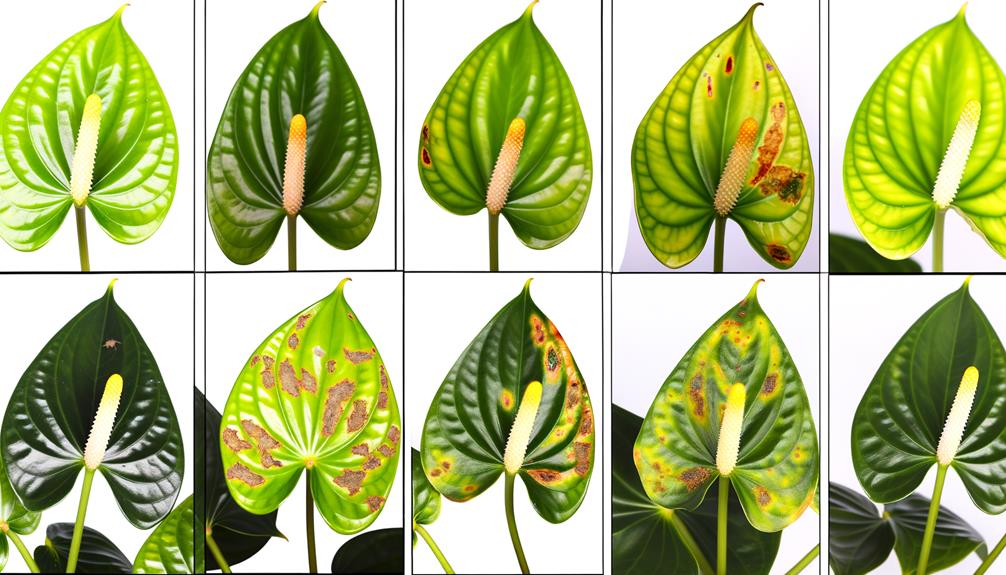
Inevitably, Anthurium King and Queen plants can fall victim to various pests and diseases, such as spider mites, aphids, and root rot, which can severely impact their health and growth.
Spider mites, often found on the undersides of leaves, suck plant sap, leading to stippling and discoloration. Aphids, small insects, also extract sap and can introduce harmful viruses.
Root rot, caused by waterlogged soil, deprives roots of oxygen, resulting in decay.
Combat these issues with:
- Regular inspections: Early detection is essential.
- Proper watering techniques: Avoid overwatering to prevent root rot.
- Biological controls: Use beneficial insects like ladybugs to manage aphids.
Propagation Methods
Despite the threats posed by pests and diseases, you can successfully propagate Anthurium King and Queen plants through methods like stem cuttings and division, promoting robust new growth.
For stem cuttings, select a healthy stem with at least two nodes. Use a sterile knife to cut below a node, then plant in a well-draining, sterile medium. Maintain humidity and indirect light.
For division, gently remove the plant from its pot and separate the root clumps, verifying each section has roots and foliage. Replant divisions in appropriately sized containers with rich, airy soil. Keep the soil consistently moist but not waterlogged.
Both methods promote genetic continuity and vigor, enabling you to expand your collection with ease and resilience.
Conclusion
Caring for Anthurium King and Queen is much like tending to a royal garden. Make sure they bask in indirect light, stay hydrated but not waterlogged, and thrive in well-draining soil.
Maintain temperatures akin to a tropical rainforest and provide regular feedings with balanced fertilizer. Vigilance against pests and diseases is essential, and propagation can be your secret to expanding your botanical kingdom.
With dedication, your anthuriums will reign supreme, flourishing with regal splendor.

